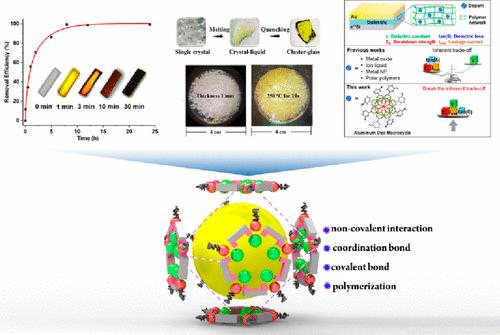当前位置:
X-MOL 学术
›
Acc. Chem. Res.
›
论文详情
Our official English website, www.x-mol.net, welcomes your feedback! (Note: you will need to create a separate account there.)
Induced Aggregation, Solvent Regulation, and Supracluster Assembly of Aluminum Oxo Clusters
Accounts of Chemical Research ( IF 18.3 ) Pub Date : 2024-04-23 , DOI: 10.1021/acs.accounts.4c00143 Wei-Hui Fang 1 , Yu-Long Xie 1 , San-Tai Wang 1 , Ya-Jie Liu 1 , Jian Zhang 1
Accounts of Chemical Research ( IF 18.3 ) Pub Date : 2024-04-23 , DOI: 10.1021/acs.accounts.4c00143 Wei-Hui Fang 1 , Yu-Long Xie 1 , San-Tai Wang 1 , Ya-Jie Liu 1 , Jian Zhang 1
Affiliation

|
Recent years have witnessed the development of cluster materials as they are atomically precise molecules with uniform size and solution-processability, which are unattainable with traditional nanoparticles or framework materials. The motivation for studying Al(III) chemistry is not only to understand the aggregation process of aluminum in the environment but also to develop novel low-cost materials given its natural abundance. However, the Al-related clusters are underdeveloped compared to the coinage metals, lanthanides, and transition metals. The challenge in isolating crystalline compounds is the lack of an effective method to realize the controllable hydrolysis of Al(III) ions. Compared with the traditional hydrolysis of inorganic Al(III) salts in highly alkaline solutions and hydrolysis of aluminum trialkyl compounds conducted carefully in an inert operating environment, we herein developed an effective way to control the hydrolysis of aluminum isopropanol through an alcoxalation reaction. By solvothermal/low melting point solid melting synthesis and using “ligand aggregation, solvent regulation, and supracluster assembly” strategies, our laboratory has established an organic-inorganic hybrid system of aluminum oxo clusters (AlOCs). The employment of organic ligands promotes the aggregation and slows the hydrolysis of Al(III) ions, which in turn improves the crystallization process. The regulation of the structure types can be achieved through the selection of ligands and the supporting solvents. Compared with the traditional condensed polyoxoaluminates, we successfully isolated a broad range of porous AlOCs, including aluminum molecular rings and Archimedes aluminum oxo cages. By studying ring expansion, structural transformation, and intermolecular supramolecular assembly, we demonstrate unique and unprecedented structural controllability and assembly behavior in cluster science. The advancement of this universal synthetic method is to realize materials customization through modularly oriented supracluster assembly. In this Account, we will provide a clear-cut definition and terminology of “ligand aggregation, solvent regulation, and supracluster assembly”. Then we will discuss the discovery in this area by using a strategy, such as aluminum molecular ring, ring size expansion, ring supracluster assembly, etc. Furthermore, given the internal and external pore structures, as well as the solubility and modifiability of the AlOCs, we will demonstrate their potential applications in both the solid and liquid phases, such as iodine capture, the optical limiting responses, and dopant in polymer dielectrics. The strategy herein can be applied to extensive cluster science and promote the research of main group element chemistry. The new synthetic method, fascinating clusters, and unprecedented assembly behaviors we have discovered will advance Al(III) chemistry and will also lay the foundation for functional applications.
中文翻译:

铝氧簇的诱导聚集、溶剂调节和超簇组装
近年来,团簇材料得到了发展,因为它们是原子级精确的分子,具有均匀的尺寸和溶液可加工性,这是传统纳米颗粒或框架材料无法实现的。研究 Al(III) 化学的动机不仅是为了了解铝在环境中的聚集过程,也是为了开发新型低成本材料(鉴于其天然丰富性)。然而,与造币金属、镧系元素和过渡金属相比,与铝相关的簇并不发达。分离晶体化合物的挑战是缺乏有效的方法来实现 Al(III) 离子的可控水解。与传统的在高碱性溶液中水解无机Al(III)盐和在惰性操作环境中仔细进行三烷基铝化合物的水解相比,我们开发了一种通过烷酰化反应控制异丙醇铝水解的有效方法。本实验室通过溶剂热/低熔点固熔合成,采用“配体聚集、溶剂调控、超团簇组装”策略,建立了铝氧簇(AlOCs)的有机-无机杂化体系。有机配体的使用促进了Al(III)离子的聚集并减缓了水解,从而改善了结晶过程。结构类型的调控可以通过配体和支持溶剂的选择来实现。与传统的稠合多氧铝酸盐相比,我们成功分离出多种多孔AlOC,包括铝分子环和阿基米德铝氧笼。通过研究环膨胀、结构转变和分子间超分子组装,我们展示了簇科学中独特且前所未有的结构可控性和组装行为。这种通用合成方法的进步是通过模块化的超簇组装来实现材料定制。在本报告中,我们将提供“配体聚集、溶剂调节和超簇组装”的明确定义和术语。然后我们将通过铝分子环、环尺寸膨胀、环超团簇组装等策略来讨论这一领域的发现。此外,考虑到AlOCs的内部和外部孔隙结构,以及溶解度和可改性性,我们将展示它们在固相和液相中的潜在应用,例如碘捕获、光学限制响应和聚合物电介质中的掺杂剂。该策略可广泛应用于团簇科学,促进主族元素化学的研究。我们发现的新合成方法、令人着迷的团簇和前所未有的组装行为将推动 Al(III) 化学的发展,也将为功能应用奠定基础。
更新日期:2024-04-24
中文翻译:

铝氧簇的诱导聚集、溶剂调节和超簇组装
近年来,团簇材料得到了发展,因为它们是原子级精确的分子,具有均匀的尺寸和溶液可加工性,这是传统纳米颗粒或框架材料无法实现的。研究 Al(III) 化学的动机不仅是为了了解铝在环境中的聚集过程,也是为了开发新型低成本材料(鉴于其天然丰富性)。然而,与造币金属、镧系元素和过渡金属相比,与铝相关的簇并不发达。分离晶体化合物的挑战是缺乏有效的方法来实现 Al(III) 离子的可控水解。与传统的在高碱性溶液中水解无机Al(III)盐和在惰性操作环境中仔细进行三烷基铝化合物的水解相比,我们开发了一种通过烷酰化反应控制异丙醇铝水解的有效方法。本实验室通过溶剂热/低熔点固熔合成,采用“配体聚集、溶剂调控、超团簇组装”策略,建立了铝氧簇(AlOCs)的有机-无机杂化体系。有机配体的使用促进了Al(III)离子的聚集并减缓了水解,从而改善了结晶过程。结构类型的调控可以通过配体和支持溶剂的选择来实现。与传统的稠合多氧铝酸盐相比,我们成功分离出多种多孔AlOC,包括铝分子环和阿基米德铝氧笼。通过研究环膨胀、结构转变和分子间超分子组装,我们展示了簇科学中独特且前所未有的结构可控性和组装行为。这种通用合成方法的进步是通过模块化的超簇组装来实现材料定制。在本报告中,我们将提供“配体聚集、溶剂调节和超簇组装”的明确定义和术语。然后我们将通过铝分子环、环尺寸膨胀、环超团簇组装等策略来讨论这一领域的发现。此外,考虑到AlOCs的内部和外部孔隙结构,以及溶解度和可改性性,我们将展示它们在固相和液相中的潜在应用,例如碘捕获、光学限制响应和聚合物电介质中的掺杂剂。该策略可广泛应用于团簇科学,促进主族元素化学的研究。我们发现的新合成方法、令人着迷的团簇和前所未有的组装行为将推动 Al(III) 化学的发展,也将为功能应用奠定基础。



























 京公网安备 11010802027423号
京公网安备 11010802027423号